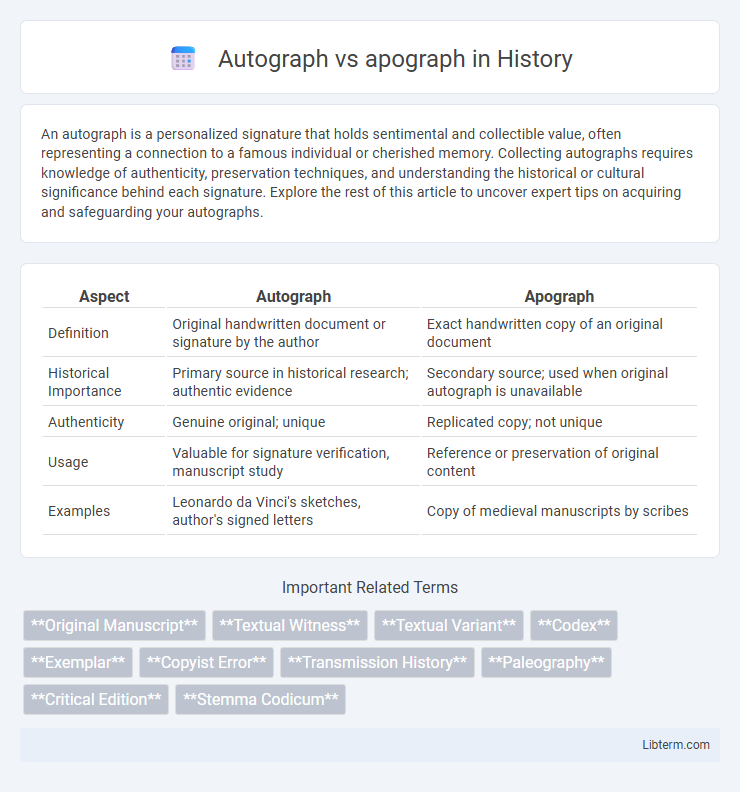An autograph is a personalized signature that holds sentimental and collectible value, often representing a connection to a famous individual or cherished memory. Collecting autographs requires knowledge of authenticity, preservation techniques, and understanding the historical or cultural significance behind each signature. Explore the rest of this article to uncover expert tips on acquiring and safeguarding your autographs.
Table of Comparison
| Aspect | Autograph | Apograph |
|---|---|---|
| Definition | Original handwritten document or signature by the author | Exact handwritten copy of an original document |
| Historical Importance | Primary source in historical research; authentic evidence | Secondary source; used when original autograph is unavailable |
| Authenticity | Genuine original; unique | Replicated copy; not unique |
| Usage | Valuable for signature verification, manuscript study | Reference or preservation of original content |
| Examples | Leonardo da Vinci's sketches, author's signed letters | Copy of medieval manuscripts by scribes |
Understanding Autograph and Apograph: Key Definitions
Autograph refers to a document or manuscript written entirely in the author's own handwriting, serving as a primary source with high authenticity and historical value. Apograph, by contrast, is a faithful copy or transcript of the original autograph, often produced to preserve the content while the original remains inaccessible or fragile. Understanding these terms is crucial in textual scholarship, as autographs provide direct insight into the author's intent, whereas apographs ensure wider dissemination and preservation of the work.
Historical Significance of Autographs and Apographs
Autographs hold profound historical significance as original handwritten documents authored by notable figures, providing authentic insights into their thoughts, decisions, and era. Apographs, being exact copies of these originals, preserve the content when autographs are lost or inaccessible, ensuring continuity in historical records and scholarly research. The study and authentication of autographs and apographs contribute to understanding historical contexts, provenance, and the transmission of knowledge over time.
Autograph vs Apograph: Core Differences
Autograph refers to a document or signature written entirely in the original author's handwriting, serving as a unique and authentic representation of their work. Apograph, in contrast, denotes a faithful copy or replica of the original manuscript, often produced later and lacking the original author's direct handwriting. Core differences lie in authenticity, originality, and value, with autographs holding higher significance in historical, legal, and collectible contexts compared to apographs.
Role in Textual Criticism and Manuscript Studies
Autograph refers to the original manuscript written by the author, serving as the primary source for establishing an authoritative text, while apograph denotes any exact copy of that original. In textual criticism and manuscript studies, autographs are invaluable for verifying authorial intent and detecting textual variants, but apographs often provide crucial evidence when originals are lost or inaccessible. Scholars analyze discrepancies between autographs and apographs to reconstruct the most authentic version of a text and understand its transmission history.
Reliability of Autographs in Authenticity Verification
Autographs, being original documents or signatures created by the author or artist, are considered highly reliable for authenticity verification due to their direct provenance and unique characteristics. In contrast, apographs are copies or reproductions, which lack the intrinsic evidential value present in autographs, rendering them less trustworthy in validating authenticity. The reliance on autographs is crucial in legal, historical, and collectible contexts where verifying genuineness depends on analyzing specific markers such as ink, paper, and handwriting traits.
The Importance of Apographs in Document Preservation
Apographs, as accurate copies of original manuscripts, play a crucial role in document preservation by safeguarding the content against loss or damage to the autograph, the original handwritten document. They ensure the continuity of historical, legal, and literary records, especially when the autograph is vulnerable to deterioration or destruction. Preservation efforts rely heavily on apographs to maintain the authenticity and accessibility of important texts for future generations.
Notable Examples: Famous Autographs and Apographs
Notable examples of autographs include manuscripts like Leonardo da Vinci's *Codex Leicester* and Shakespeare's handwritten plays, which provide valuable insights into authorship and historical context. Famous apographs often appear in religious texts, such as the Septuagint and the Dead Sea Scrolls, which are copies of original scriptures used for textual analysis and preservation. Collectors and scholars highly value autographs for their originality, while apographs are critical for verifying the transmission and authenticity of significant documents.
Challenges in Identifying Genuine Autographs
Identifying genuine autographs presents challenges due to the prevalence of skilled forgeries and the subtle variations in an individual's handwriting over time. Authentication requires expertise in forensic document analysis, including ink composition, paper aging, and signature comparison against verified exemplars. Distinguishing an autograph, an original handwritten signature, from an apograph, a copy or facsimile, demands meticulous examination of microscopic features and provenance documentation to prevent misattribution and ensure collector confidence.
Impact of Apographs on Scholarly Research
Apographs, as exact copies of original manuscripts or documents, have significantly impacted scholarly research by providing accessible and multiple versions of primary sources for analysis. These copies enable researchers to verify textual accuracy, compare variations, and preserve historical content, especially when original autographs are lost or damaged. The availability of apographs thus enhances the reliability and depth of academic studies across disciplines such as history, literature, and biblical scholarship.
Future Trends in the Study of Autographs and Apographs
Future trends in the study of autographs and apographs emphasize advancements in digital authentication technologies and blockchain integration to enhance provenance verification. Machine learning algorithms are increasingly employed to analyze handwriting characteristics, distinguishing original autographs from apographs with greater accuracy. Collaborative databases and augmented reality applications are emerging tools to facilitate real-time access and verification for collectors, historians, and researchers worldwide.
Autograph Infographic

 libterm.com
libterm.com